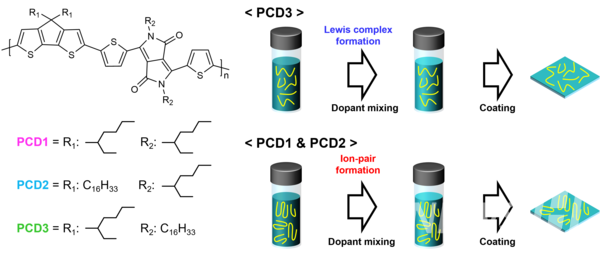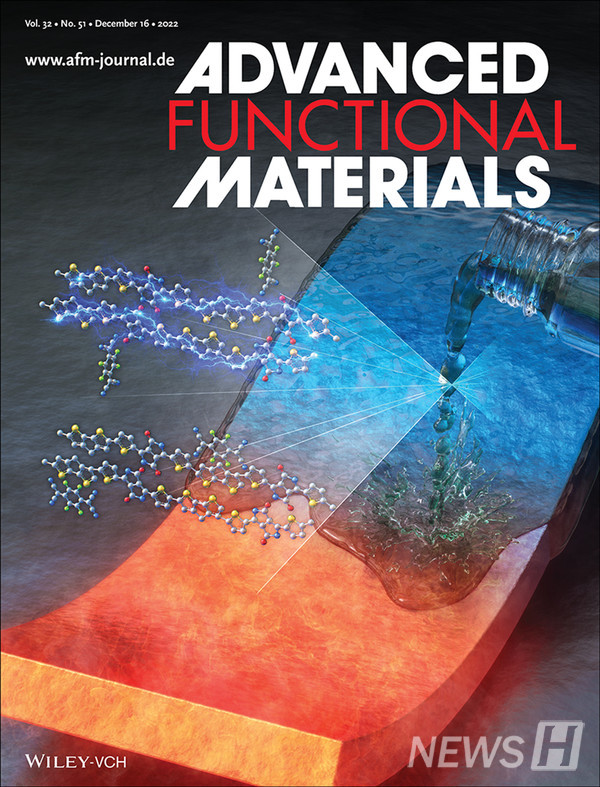Performance improvement and process simplification of various electronic devices are possible
On December 20, Hanyang University has announced Professor Jang Jae-young of Hanyang University's Department of Energy Engineering, Jung In-hwan of Hanyang University's Department of Organic and Nano Engineering, and Jeong Yong-jin of Korea National University of Transportation have identified the principle of molecular doping reaction of conjugated polymers in solutions.
This technology is expected to reduce production costs by improving the performance of various electronic devices consisting of conjugated polymers such as energy harvesting devices, organic light emitting diodes (OLEDs), and organic transistors.
The conjugated structure in which several carbon atoms repeatedly form single-double bonds one after another is a key structure that gives semiconductor properties to organic materials. Among various organic substances, conjugated polymers in which monomers with a myriad of conjugated structures such as plastic are repeatedly connected, are being studied as key materials for wearable electronic devices due to their bending and stretching characteristics. Particularly, the "molecular doping" technology, which mixes additives in molecular form to control the properties of conjugated polymers, is recently drawing attention from many researchers.
Among the various additives, "2,3,5,6-tetrafluoro-7,7,8,8-tetracyanoquinodimethane" (hereinafter referred to as F4TCNQ) is a substance with strong oxidation and excellent chemical stability. Though numerous studies have been conducted on doping reactions using F4TCNQ, there is still a lack of understanding of doping behaviors in solution-state polymers. In addition, there has been a need for a "solution mixing method" that can simplify the process and reduce costs by mixing conjugated polymers and additives in solution-state.
The joint researchers synthesized three conjugated polymers with the same main chain structure but different side chains to reveal the principle of doping behavior in the solution-state of F4TCNQ. The main chain has a conjugated structure and serves as a channel through which electric charges move, and the side chain is attached to the main chain as a side branch to dissolve the polymer in a solvent.
The researchers adjusted the side chain to change the solubility of the three polymers. As a result, the lower the solubility, the more cohesion was found in the solution. Also, the more cohesive of the polymer, the more efficient the doping reaction occurred. When coated with a thin film using such a doped polymer solution, efficient doping increases the number of charges in the main chain serving as a path to improve the electrical conductivity and thermoelectric properties of the thin film.
The researchers demonstrated that side chains not only give solubility to conjugated polymers, but also control the degree of agglomeration in solution-state, thereby resulting in significant improvement of doping efficiency and organic thermoelectric devices' performance.
This study is significant in that it not only has improved the performance of conjugated polymer-based electronic devices with the improved doping efficiency in solution-state but also has reduced manufacturing costs with simplified process.
Professor Jang Jae-young said, "This study will help in-depth understanding of effects that side chains of conjugated polymers has on solution-state doping reactions, as well as reduce costs with introduction of large-area solution processes."
The research which is Funded by the Ministry of Science and ICT (leading research center support project, mid-sized researcher support project, basic research laboratory project, nano and material technology development project and artificial intelligence graduate school support project), and supported from the National Research Foundation of Korea and Hanyang University intramural research support project was published on the 16th of Advanced Functional Materials, a world-renowned journal in the field of materials science, which was also selected as a cover paper.



Click to see the paper:


 '한양위키' 키워드 보기
'한양위키' 키워드 보기